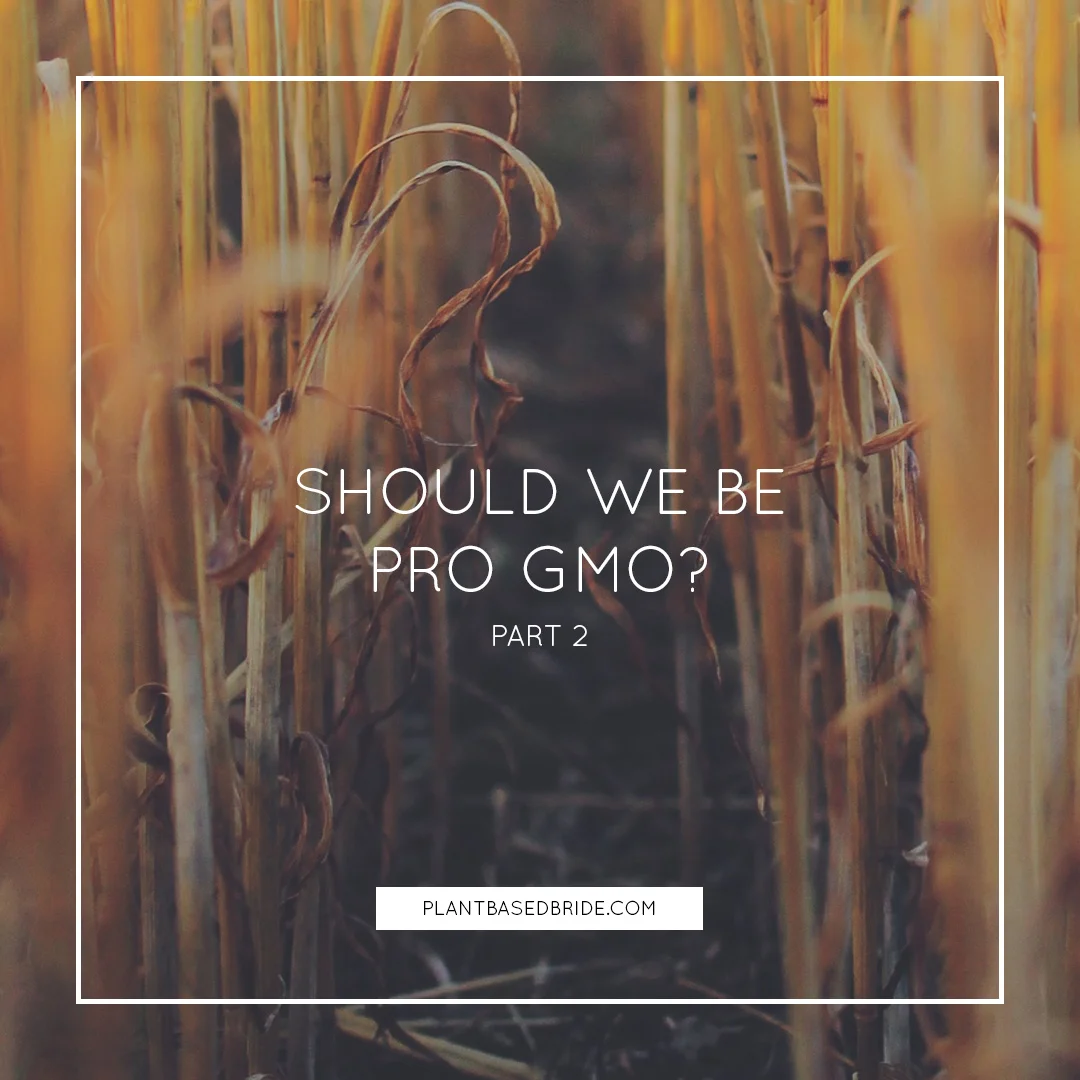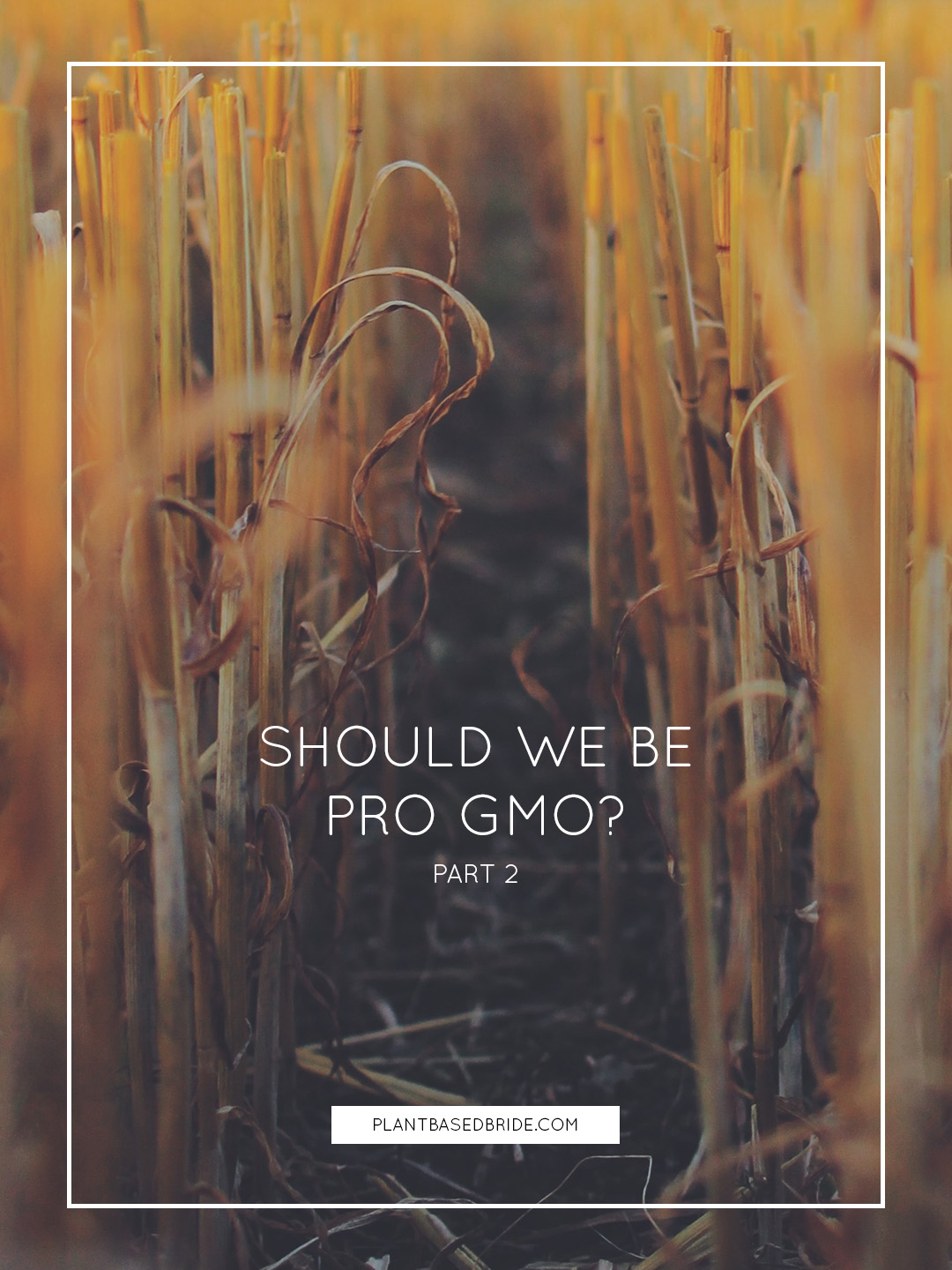
the blog.
Should We Be Pro GMO? (Part 2)
Welcome back to the second part of my 2-part series on GMOs! Last week we talked about the health impacts of GMOs and their effect on animals. (Go read that article here, if you haven't already!) This week we'll chat GMOs and the environment, and briefly touch on the "big bad monster" of the industry - Monsanto.
Welcome back to the second part of my 2-part series on GMOs! Last week we talked about the health impacts of GMOs and their effect on animals. (Go read that article here, if you haven't already!) This week we'll chat GMOs and the environment, and briefly touch on the "big bad monster" of the industry - Monsanto.
So, what are the impacts of GMOs on the environment?
Water use
One side claims that additional traits engineered into GMO crops cause them to require more irrigation, while the other states that organic farming is the one that requires more water. So which is it?
Kristine Nichols, the chief scientist for the Rodale Institute, put it this way:
"I like to say that microorganisms are like little engineers. They build out these systems and engineer the environment to be beneficial for the plants so that the plants will feed them in turn."
She's referring to the ability of these microorganisms to build up in organically farmed soil, forming mutually dependent relationships with the plants. Fungi, for example, create microscopic channels that carry nutrients and water through the soil.
This results in the soil in organic fields absorbing more water, storing that water better, and needing less water overall. Organic soil also did better at replenishing groundwater supplies in this study. This ability of the soil allows for organic crops to draw on plentiful water during drought. Conventional and GM crops do not have this ability due to the soil's reduced ability to store water.
However, some farmers, like Joel Nelson (the President of the California Citrus Mutual growers association), are skeptical about differences in water use. He said:
"Organic HAS NOTHING to do with water usage. Our organic producers achieve a yield, generally 40 percent less than conventional producers, but all of them require the same amount of water."
As there are so many other factors involved in water requirements for crops, it's difficult to say who's right.
Land use and destruction of natural habitats
While GMOs don't necessarily produce higher yields than non-GMOs (as seen in GM cotton in India, which we will discuss later), organic crops have been shown to produce only around 80% of the yield potential from a conventional crop per unit of land. For this reason, organic farming actually requires more land to feed the same number of people as conventional agriculture.
Many of you are likely already aware of the 850 million hungry people in the world, and the rainforest destruction of approximately an acre per second, mostly for agricultural purposes. Using MORE land to produce the same amount of food is in no way environmentally friendly.
However, you may also already be aware that it takes ten times more crops to feed people when we first filter the crops through animals, rather than feeding the plants to humans directly. In other words, animal products produce only 10% of the yields of plants, however they're grown. For every 10 lbs of grain fed to a cow, only 1 lb of beef will be produced.
If we really want to feed the hungry without using more land, we should be reducing our meat and other animal product consumption. For this reason, I find the 'land use' argument for GMOs less than compelling.
Pollution by synthetic fertilizers and pesticides
Firstly, I want to make it clear that organic farms still use pesticides. It is a commonly held belief that organic farms use little to no pesticides, but that is simply a misconception. In reality, organic farms can use as many if not more pesticides on their crops due to lowered effectiveness. Sadly, large farms (organic or not) are more concerned with yield and profit than the health of the soil, the environment, and consumers. They often use pesticides liberally to reduce competition from other plants. The difference is that organic farms use organic pesticides, rather than synthetic ones.
So what's worse: organic or synthetic pesticides?
Organic pesticides come from natural sources and are un- or lightly-processed before use, rather than being developed synthetically. It has long been thought that organic compounds are safer for us and the environment, but many natural pesticides have been found to have serious health risks.
An example is Rotenone, a highly dangerous natural pesticide which has been shown to produce Parkinson's Disease-like symptoms in rats. It is potentially deadly to various species, including humans. Just because something is natural, doesn't mean it can't kill you.
More and more testing is showing that many organic pesticides, believed to be safe, are not.
But are synthetic pesticides any better?
A Canadian study found that organic pesticides meant to control soybean aphids were actually more ecologically damaging than the synthetic pesticides, as well as less effective.
Unfortunately, one blanket statement can't be made. It depends so greatly on the specific farm and its specific practices. Some organic farms use no pesticides, as do some conventional farms. Some conventional farms spray pesticides twice a month, and some organic farms spray just as frequently.
The only way to know is to buy local produce and actually talk to the farmer about their practices.
One thing we can say for certain is that overuse of pesticides and herbicides is a problem. Hundreds of millions of pounds of herbicides and pesticides are applied to farmlands. As a result, weeds and pests are becoming resistant to compounds such as glyphosate - leading to the use of stronger herbicides, such as with the case of Pig Weed's resistance to Roundup after a couple of decades of use.
The increased use of herbicides and pesticides in conjunction with both organic and GMO crops leads to pollution of water, soil, and air.
This is a problem that cannot simply be ignored.
Conservation of soils and biodiversity of crops and wildlife
We spoke of how organic farming often leads to healthier soil, full of microorganisms and fungi. In contrast, GM crops' roots can release toxins into the soil leading to fewer soil bacteria - integral to healthy, nutritious soil, needed for proper growth without chemical fertilizers. In addition to the impact on the soil, irrigation of these GM crops carries these toxins into our water and air - exposing various plant and animal species to the negative effects.
It is also true that organic farms tend to favour crop rotation rather than monoculture. The rotation of crops helps substantially in preventing soil degradation. GM crops are far more likely to be grown as monocultures, depleting the soil of important nutrients and reducing diversity. In a monoculture style of farming, nutrients are not returned to the soil - allowing it to become dry and void of nutrients.
The "strong" genes of GM species may lead to a large-scale whipping out of other varieties of plants, reducing the diversity of life on Earth in an irreversible fashion. Once GM DNA has been introduced to the environment, it cannot be extracted.
Gene flow, invasiveness and super weeds
Gene flow, the movement of genes from one population of plants to another by way of pollen and seeds, is cited as a reason for caution in using GMO crops. As GM seeds spread, as does their altered DNA - small genetic alterations in plants may cause much larger ecological shifts. These GMOs have the potential to overtake other, "weaker", plants in both agricultural and natural conditions. GMO plants have the ability to become invasive species in our already fragile natural ecosystems, as occurred in North Dakota in 2010 with GM canola. It is impossible to know the reprocussions of this kind of spreading of GM plants. Once a plant has been introduced, it will inevitably become part of a larger ecosystem.
There is also the problem of 'super weeds' - non-target plants that become resistant to pesticides and herbicides and have the potential to take over agricultural and natural habitats in much the same way as genetically engineered crops.
Fuel use
As of now, there seems to be no substantial difference in the fuel use by organic and GM farms. There is, however, the potential to engineer crops able to fix their own nitrogen - a trait that could drastically reduce energy consumption on farms by eliminating the natural gas currently used in synthesizing ammonium nitrate and the fuel used in trucks that transport fertilizers to farms.
What about Monsanto?
Monsanto has become synonymous with the 'evil corporation'. There are horror stories of lies, mistreatment of farmers, and lawsuits. Some of these stories are true, and some aren't, but that's not really the point. A vast majority of large-scale corporations have questionable ethics in the face of potential profit, and Monsanto is no different. These include less-than-ethical business practices, extreme opposition to transparent labelling, and the revolving door of employees between Monsanto, the USDA, the FDA, and the US government.
The problem with patenting seeds
Monsanto is at the centre of the seed patenting debate because they are the largest seed company in the world. They have taken over the majority of seed companies and control 95% of the cotton in India and 90% of the soy in the US, not to mention large amounts of other crops.
Everything begins with a seed - seeds are the source of life, and renewal of life. Monsanto is trying to privatize it. The patenting of a seed is problematic is so many ways. Private companies shouldn't control the first step in the food chain any more than governments should. We need seeds to survive, and we as individuals should have the right to grow food.
Dr. Vandana Shiva has pointed out that the only way to claim a patent on a seed is to alter it, to genetically engineer it. Once this has been done, the seed can be claimed as an invention, as intellectual property. This allows a private company to exclude others from having or using these seeds. This is a slippery slope, and dangerous for our already flawed food system. There is no benefit for the larger population in the patenting of seeds. This is simple corporate greed.
The patenting also causes another issue - it allows Monsanto to restrict independent scientific research on their seeds, making it almost entirely impossible for independent entities to verify their claims. Monsanto says that GM crops are superior to non-GM crops, but they don't allow scientists without ties to the corporation the freedom to study them.
Many point to cross-pollination of GM and non-GM crops as one of the biggest problems with GMOs. They talk of Monsanto's criminal suits against farmers whose crops were contaminated by patented seeds. Further research seems to indicate that this is less of a problem than we have been made to think.
However, there is still a real impact on farmers.
Impact on farm workers
The severe impact of Monsanto's business practices on small farmers is never clearer than in India.
Since the introduction of Monsanto's Bt cotton to India in 1998, the price of cotton seeds has increased by almost 80,000%. (Yes, 80,000%, that's not a typo.) This exorbitant price increase combined with the fact that new seeds must be purchased every year have lead to economic hardship among small farmers in India. In addition to these problems, far lower yields than promised (the claim from Monsanto was 1,500 kg of cotton per acre, while the average actual yield was only 400 kg of cotton per acre) leaves farmers without future prospects. As a result, approximately 300,000 Indian farmers have committed suicide after being trapped in cycles of debt and crop failure. 84% of these deaths have been directly associated with Monsanto's Bt cotton.
There is also an impact on the farmers in their physical health due to close proximity to toxic chemicals such as those found in Roundup. Entire communities have been impacted in places like South America, where thousands of families who have been farming the land for generations have been displaced to poor urban areas due to their inability to compete with agribusiness conglomerates growing GM crops. There have even been reports of killings of farmers who have protested the loss of their livelihoods.
You may have noticed that the question of the safety and validity of GMOs is not cut and dry, not black and white. Can GMO crops be good for people? Yes, they can. Can they be good for the environment, with proper development? I think so. There are so many pieces to this puzzle; so many variables.
GMOs aren't inherently bad, but they also aren't inherently good.
Right now, today, they bring bad things along with them. Monsanto and the patenting of life. Pesticides and herbicides and their severe impact on our health, the animals, and the environment. Monoculture and soil depletion.
The problem? Organic farms aren't all that much better. Our food system is broken, and none of our current options can fix it.
A truly sustainable future would utilize more natural processes, such as many of those used in organic farming, in combination with technological advancement to create nutritious crops that can be grown responsibly with net positive outcomes for the soil and environment.
A sustainable future would see advancement for the good of humanity, the animals, and our planet without privatization and monopolies controlled by big corporations.
We need to encourage boh sides to work together to find our best bet for a sustainable future. As allies, the GM and organic industries could revolutionize our food system for the better.
I hope you enjoyed this two-part series on GMOs and would love to hear your thoughts in the comments.
Until next time,
Sources:
https://www.youtube.com/watch?v=9_izCPy7yvs
http://www.mdpi.com/1099-4300/15/4/1416
http://www.mdpi.com/1099-4300/15/4/1416/htm
https://www.youtube.com/watch?v=aA4I-WRu_s0
http://www.onegreenplanet.org/animalsandnature/the-environmental-impact-of-gmos/
https://www.researchgate.net/profile/Jacek_Strojny2/publication/293647479_IS_GMO_SUSTAINABLE_A_REVIEW_OF_THE_ENVIRONMENTAL_RISKS_OF_GM_PLANTS_IN_COMPARISON_WITH_CONVENTIONAL_AND_ORGANIC_CROPS/links/56e1cad508aebc9edb19c87f.pdf
http://www.cnbc.com/2014/12/09/rought-resistant-report.html
https://blogs.scientificamerican.com/science-sushi/httpblogsscientificamericancomscience-sushi20110718mythbusting-101-organic-farming-conventional-agriculture/
https://www.geneticliteracyproject.org/2013/10/15/organics-versus-gmo-why-the-debate/
https://vimeo.com/45691238/description
http://www.foodispower.org/gmosnanofoods/
http://environment.nationalgeographic.com/environment/global-warming/food-how-altered/
http://www.fao.org/docrep/003/X9602E/x9602e07.htm
http://earthjustice.org/features/engineering-an-environmental-disaster-2#
http://www.ewg.org/agmag/2016/03/are-gmos-bad-environment
http://centaur.reading.ac.uk/39676/
http://www.nature.com/nbt/journal/v20/n6/abs/nbt0602-567.html
http://www.lcafood2014.org/papers/137.pdf
http://gmo.geneticliteracyproject.org/FAQ/organic-non-gmo-farming-sustainable-farming-using-gmos/
http://www.navdanya.org/news/573-monsanto-vs-indian-farmers
Should We Be Pro GMO? (Part 1)
GMOs. Are they good or bad? They've been a talking point for quite a while now, with vegans and non-vegans everywhere sharing their two cents on the matter. I've pretty much stayed out of it. I've heard things, I've watched some videos on the topic, but I'm no expert. Today, I'm going to lay out my understanding of the available evidence in the hopes that we can determine once and for all if we should be avoiding GMOs or embracing them.
Or just leave even further confused by the conflicting evidence.
GMOs. Are they good or bad? They've been a talking point for quite a while now, with vegans and non-vegans everywhere sharing their two cents on the matter. I've pretty much stayed out of it. I've heard things, I've watched some videos on the topic, but I'm no expert. Today, I'm going to lay out my understanding of the available evidence in the hopes that we can determine once and for all if we should be avoiding GMOs or embracing them.
Or just leave even further confused by the conflicting evidence.
To start, what are GMOs?
Well, they're genetically modified organisms.
When did we start modifying the genes of organisms?
We’ve been modifying organisms for the entire history of agriculture with selective breeding of plants and animals. Current GMOs are more accurately described as “genetically engineered organisms". This (relatively) new form of modification was first done in labs in the 1920s and involves fusing the genes from one species into another in a process called transgenesis.
Why do we genetically modify organisms?
One reason we began modifying foods was in hopes of higher yields.
We still do it for this reason.
It is claimed that genetically modified foods allow for more yield per area of land, meaning we can feed more people without further destruction of our planet (such as deforestation in the amazon for agriculture). But do GMOs really improve yields? One argument to the contrary claims that it is in fact the opposite, due to the proliferation of glyphosate (the active ingredient in the herbicide, Roundup). The herbicide depletes the soil of essential nutrients and beneficial organisms, reducing the quality of the soil. This reduced soil quality leads to slowed crop development and diseases, resulting in lower yields.
It has also been stated that GMOs are no better at tolerating poor soil or unstable climate conditions than non-engineered crops. This flies in the face of the common pro-GMO argument of ensuring food security. Claims that GMOs are the way to feed the hungry and support a growing human population don't seem to be supported by all of the data, which shows that natural breeding methods used to develop flood-tolerant rice, drought-tolerant maize, and pest-resistant chickpeas may in fact be more effective in this arena. We do know, however, that we already grow enough crops to feed 10-11 billion people if we redistribute these crops to humans, rather than filtering them first through livestock. This filtering of our food supply through animals leads to an energy yield reduction of 90%.
What foods tend to be genetically modified?
Most GMOs are used as animal feed and in processed foods. Over 90% of soy, corn, canola, and sugar beets in the US have been genetically engineered.
What are the impacts of GMOs on human health?
Glyphosate (Roundup) is the most commonly used herbicide for GMO crops. It was previously determined to be safe for mammals, as the way it kills plants is through the disruption of the shikimate pathway, involved in the synthesis of important amino acids and other components. It is widely considered safe for animals, as we do not possess this pathway to be disrupted.
However, a recent study casts doubt on its safety. The study found that glyphosate inhibits cytochrome P450 (CYP enzymes) which play important biological roles in the human body. Exposure to glyphosate 'enhances the damaging effects of other foodborne chemical residues and environmental toxins' with a negative impact on the human body which is both 'insidious and manifests slowly over time...'
Here I will include the full abstract of the recent study for reference:
'Glyphosate, the active ingredient in Roundup®, is the most popular herbicide used worldwide. The industry asserts it is minimally toxic to humans, but here we argue otherwise. Residues are found in the main foods of the Western diet, comprised primarily of sugar, corn, soy and wheat. Glyphosate's inhibition of cytochrome P450 (CYP) enzymes is an overlooked component of its toxicity to mammals. CYP enzymes play crucial roles in biology, one of which is to detoxify xenobiotics. Thus, glyphosate enhances the damaging effects of other food borne chemical residues and environmental toxins. Negative impact on the body is insidious and manifests slowly over time as inflammation damages cellular systems throughout the body. Here, we show how interference with CYP enzymes acts synergistically with disruption of the biosynthesis of aromatic amino acids by gut bacteria, as well as impairment in serum sulfate transport. Consequences are most of the diseases and conditions associated with a Western diet, which include gastrointestinal disorders, obesity, diabetes, heart disease, depression, autism, infertility, cancer and Alzheimer’s disease. We explain the documented effects of glyphosate and its ability to induce disease, and we show that glyphosate is the “textbook example” of exogenous semiotic entropy: the disruption of homeostasis by environmental toxins.' (Read the full study here)
This study seems to indicate that there is, in fact, a negative health impact on humans from the use of GMOs. If not from the GMO crops themselves, at least from the herbicides used in conjunction with them.
There are claims of the positive health impact potential of GMO crops, as seen with golden rice. This variety of rice was infused with beta keratin to provide Vitamin A to populations of humans suffering from severe deficiency. Preventing blindness in children is a noble task, but what negative impacts may be carried along with the good?
We simply don't know how GMOs affect genomes and the full picture of their impact on our health as a whole. More than 50 countries have restricted GMO crops and passed laws to require labelling of GMOs.
What are the impacts of GMOs on the health of non-human animals
There are both direct and indirect impacts from GMOs. First let's consider the most direct impacts: GMOs are tested on animals. Some claim this is a reason to support them, as less opposition will lead to less testing to determine safety. But seeing how we don't know that they're safe, what should we do? I'm concerned about the findings of the above study, but I am also vehemently opposed to animal testing. So how do we proceed?
A positive result of GMOs is the development of synthetic insulin. Insulin was initially derived from the ground up pancreases of cows and pigs, but now vegans and others opposed to animal suffering can access non-animal derived insulin.
An example of an unintended indirect negative impact of GMOs on non-human animals is the decimation of monarch butterflies that has occurred over the past two decades. Scientists developed a very effective herbicide called Glyphosate (colloquially known as Roundup) to be used on GMO crops. So effective, in fact, that it has the ability to kill all plants that don't have a specific gene. Scientists involved in the development of this herbicide injected the roundup-resistant gene into common crops such as soy beans and corn to effectively protect these crops from a pesticide with the ability to literally kill anything green.
When the herbicide is sprayed in a field, it kills everything within a certain radius (even outside of the limits of the field) without this injected gene. In this way it has been able to kill vast quantities of milk weed, a plant that monarch butterflies rely on for their survival. This unintended consequence of genetic modification has lead to a reduction in monarch butterfly population by as much as 90%.
How many other insects and pollinators are being negatively impacted by extremely powerful herbicides, pesticides, and GMOs?
Additionally, monoculture, made more viable by genetic modification, makes it very difficult for bees as pollinators to do their jobs and has a serious negative impact on the environment. These are unintended and indirect consequences of GMOs, and we can't know quite how serious of an impact it will turn out to be.
The more I research, the more questions I have. I want to pause here, and continue next week with a look into the impact of GMOs on the environment, as well as the true cost of corporations patenting living organisms, as Monsanto has.
If you notice errors in this post or have further information on these topics, please let me know in the comments below!
Until next time,




























